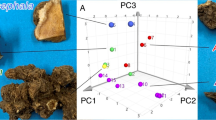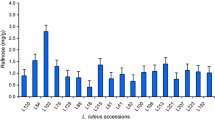Abstract
Sixty peony root training samples of the same age were collected from various regions in Korea and China, and their genetic diversity was investigated for 23 chloroplast intergenic space regions. All samples were genetically indistinguishable, indicating that the DNA-based techniques employed were not appropriate for determining the samples’ regions of origin. In contrast, 1H-nuclear magnetic resonance (1H-NMR) spectroscopy-based metabolomics coupled with multivariate statistical analysis revealed a clear difference between the metabolic profiles of the Korean and Chinese samples. Orthogonal projections on the latent structure-discrimination analysis allowed the identification of potential metabolite markers, including γ-aminobutyric acid, arginine, alanine, paeoniflorin, and albiflorin, that could be useful for classifying the samples’ regions of origin. The validity of the discrimination model was tested using the response permutation test and blind prediction test for internal and external validations, respectively. Metabolomic data of 21 blended samples consisting of Korean and Chinese samples mixed at various proportions were also acquired by 1H-NMR analysis. After data preprocessing which was designed to eliminate uncontrolled deviations in the spectral data between the testing and training sets, a new statistical procedure for estimating the mixing proportions of blended samples was established using the constrained least squares method for the first time. The predictive procedure exhibited relatively good predictability (adjusted R 2 = 0.7669), and thus has the potential to be used in the quality control of peony root by providing correct indications for a sample’s geographical origins.

1H-NMR spectroscopy-based metabolomics allowed the discrimination between genetically identical peony roots from different regions of origin and the estimation of the mixing proportions of blended samples





Similar content being viewed by others
References
He DY, Dai SM (2011) Anti-inflammatory and immunomodulatory effects of Paeonia lactiflora Pall., a traditional Chinese herbal medicine. Front Pharmacol 2:10
Guo D, Ye G, Guo H (2006) A new phenolic glycoside from Paeonia lactiflora. Fitoterapia 77(7–8):613–614
Ikeda N, Fukuda T, Jyo H, Shimada Y, Murakami N (1996) Quality evaluation on Paeoniae radix. I. Quantitative analysis of monoterpene glycosides constituents of Paeoniae radix by means of high performance liquid chromatography. Comparative characterization of the external figures, processing method and the cultivated areas. J Pharm Soc Jpn 116(2):138–147
Kamiya K, Yoshioka K, Saiki Y, Ikuta A, Satake T (1997) Triterpenoids and flavonoids from Paeonia lactiflora. Phytochemistry 44(1):141–144
Jiang D, Chen Y, Hou X, Xu J, Mu X, Chen W (2011) Influence of Paeonia lactiflora roots extract on cAMP-phosphodiesterase activity and related anti-inflammatory action. J Ethnopharmacol 137(1):914–920
Hsu F-L, Lai C-W, Cheng J-T (1997) Antihyperglycemic effects of paeoniflorin and 8-debenzoylpaeoniflorin, glucosides from the root of Paeonia lactiflora. Planta Med 63(04):323,325
Yang HO, Ko WK, Kim JY, Ro HS (2004) Paeoniflorin: an antihyperlipidemic agent from Paeonia lactiflora. Fitoterapia 75(1):45–49
Kang J, Lee S, Kang S, Kwon HN, Park JH, Kwon SW, Park S (2008) NMR-based metabolomics approach for the differentiation of ginseng (Panax ginseng) roots from different origins. Arch Pharm Res 31(3):330–336
Kim SH, Kim DH, Park J-H, Choi EJ, Park S, Lee KY, Jeon M-J, Kim YC, Sung SH (2010) Discrimination of Scrophularia spp. according to geographic origin with HPLC-DAD combined with multivariate analysis. Microchem J 94(2):118–124
Kuhnen S, Bernardi Ogliari J, Dias PF, da Silva Santos M, Ferreira AG, Bonham CC, Wood KV, Maraschin M (2010) Metabolic Fingerprint of brazilian maize landraces silk (stigma/styles) using NMR spectroscopy and chemometric methods. J Agric Food Chem 58(4):2194–2200
Lima MR, Felgueiras ML, Graca G, Rodrigues JE, Barros A, Gil AM, Dias AC (2010) NMR metabolomics of esca disease-affected Vitis vinifera cv. Alvarinho leaves. J Exp Bot 61(14):4033–4042
Pereira GE, Gaudillere J-P, Leeuwen C, Hilbert G, Maucourt M, Deborde C, Moing A, Rolin D (2006) 1H NMR metabolite fingerprints of grape berry: comparison of vintage and soil effects in Bordeaux grapevine growing areas. Anal Chim Acta 563(1–2):346–352
Staneva J, Denkova P, Todorova M, Evstatieva L (2011) Quantitative analysis of sesquiterpene lactones in extract of Arnica montana L. by 1H NMR spectroscopy. J Pharm Biomed Anal 54(1):94–99
Wen H, Jeon B, Moon S, Song Y, Kang S, Yang H-J, Song Y, Park S (2010) Differentiation of antlers from deer on different feeds using an NMR-based metabolomics approach. Arch Pharm Res 33(8):1227–1234
van Leeuwen C, Friant P, Choné X, Tregoat O, Koundouras S, Dubourdieu D (2004) Influence of climate, soil, and cultivar on terroir. Am J Enol Vitic 55(3):207–217
Kang J, Choi MY, Kang S, Kwon HN, Wen H, Lee CH, Park M, Wiklund S, Kim HJ, Kwon SW, Park S (2008) Application of a 1H nuclear magnetic resonance (NMR) metabolomics approach combined with orthogonal projections to latent structure-discriminant analysis as an efficient tool for discriminating between Korean and Chinese herbal medicines. J Agric Food Chem 56(24):11589–11595
Korean Pharmacopoeia (2007). Korea
Wang Q, Liu R, Gua H, Ye M, Huo C, Bi K, Guo D (2005) Simultaneous LC determination of major constituents in red and white peony root. Chromatographia 62:581–588
Arumugasundaram S, Ghosh M, Veerasamy S, Ramasamy Y (2011) Species discrimination, population structure and linkage disequilibrium in Eucalyptus camaldulensis and Eucalyptus tereticornis using SSR markers. PLoS One 6(12):e28252
Zhang CY, Wang FY, Yan HF, Hao G, Hu CM, Ge XJ (2012) Testing DNA barcoding in closely related groups of Lysimachia L. (Myrsinaceae). Mol Ecol Resour 12(1):98–108
Ebihara A, Nitta JH, Ito M (2010) Molecular species identification with rich floristic sampling: DNA barcoding the pteridophyte flora of Japan. PLoS One 5(12):e15136
Kim HK, Choi YH, Verpoorte R (2010) NMR-based metabolomic analysis of plants. Nat Protoc 5(3):536–549
Gilard V, Balayssac S, Malet-Martino M, Martino R (2010) Quality control of herbal medicines assessed by NMR. Curr Pharm Anal 6(4):234–245
Kim HK, Choi YH, Verpoorte R (2010) NMR-based metabolomic analysis of plants. Nat Protocols 5(3):536–549
Krishnan P, Kruger NJ, Ratcliffe RG (2005) Metabolite fingerprinting and profiling in plants using NMR. J Exp Bot 56(410):255–265
Verpoorte R, Choi Y, Kim H (2007) NMR-based metabolomics at work in phytochemistry. Phytochem Rev 6(1):3–14
Viant MR, Rosenblum ES, Tieerdema RS (2003) NMR-based metabolomics: a powerful approach for characterizing the effects of environmental stressors on organism health. Environ Sci Technol 37(21):4982–4989
Doyle J, Doyle J (1987) Genomic plant DNA preparation from fresh tissue—CTAB method. Phytochem Bull 19(11)
Kim JH, Jung JY, Choi HI, Kim NH, Park JY, Lee Y, Yang TJ (2012) Diversity and evolution of major Panax species revealed by scanning the entire chloroplast intergenic spacer sequences. Genet Resour Crop Evol 60(2):413–425
Kim JS, Kim YJ, Lee JY, Kang SS (2008) Phytochemical studies on Paeoniae radix (2)—phenolic and related compounds. Kor J Pharmacogn 39(1):28–36
Kim JS, Kim YJ, Lee SY, Kang SS (2008) Phytocheical studies on Paeoniae radix (3)—triterpenoids. Kor J Pharmacogn 39(1):37–42
Yean MH, LEE JY, Kim JS, Kang SS (2008) Studies on Paeoniae radix (1)—monoterpene glucosides. Kor J Pharmacogn 39(1):19–27
Yoo JS, Song MC, Ahn EM, Lee YH, Rho YD, Baek NI (2006) Quantitative analysis of paeoniflorin from Paeonia lactiflora using H-NMR. Nat Prod Sci 12(4):237–240
BioMagResBank (2008) http://nar.oxfordjournals.org/content/36/suppl_1/D402.abstract
Hosoki T, Nagasako T, Kimura D, Nishimoto K, Hasegawa R, Ohta K, Sugiyama M, Haruki K (1997) Classification of herbaceous peony [Paeonia lactiflora] cultivars by random amplified polymorphic DNA (RAPD) analysis. J Jpn Soc Hortic Sci 65(4):843–849
Li L, Cheng FY, Zhang QX (2011) Microsatellite markers for the Chinese herbaceous peony Paeonia lactiflora (Paeoniaceae). Am J Bot 98(2):e16–e18
Britten RJ, Rowen L, Williams J, Cameron RA (2003) Majority of divergence between closely related DNA samples is due to indels. Proc Natl Acad Sci USA 100(8):4661–4665
McCauley DE (1995) The use of chloroplast DNA polymorphism in studies of gene flow in plants. Trends Ecol Evol 10(5):198–202
Lehmensiek A, Sutherland MW, McNamara RB (2008) The use of high resolution melting (HRM) to map single nucleotide polymorphism markers linked to a covered smut resistance gene in barley. Theor Appl Genet 117(5):721–728
Montgomery J, Wittwer CT, Palais R, Zhou L (2007) Simultaneous mutation scanning and genoty** by high-resolution DNA melting analysis. Nat Protoc 2(1):59–66
Bylesjö M, Rantalainen M, Cloarec O, Nicholson JK, Holmes E, Trygg J (2006) OPLS discriminant analysis: combining the strengths of PLS-DA and SIMCA classification. J Chemometr 20(8–10):341–351
Bouché N, Fromm H (2004) GABA in plants: just a metabolite? Trends Plant Sci 9(3):110–115
Noctor G, Arisi A-CM, Jouanin L, Foyer CH (1998) Manipulation of glutathione and amino acid biosynthesis in the chloroplast. Plant Physiol 118(2):471–482
Kaplan F, Kopka J, Haskell DW, Zhao W, Schiller KC, Gatzke N, Sung DY, Guy CL (2004) Exploring the temperature-stress metabolome of Arabidopsis. Plant Physiol 136(4):4159–4168
Wang D, Tan Q-R, Zhang Z-J (2013) Neuroprotective effects of paeoniflorin, but not the isomer albiflorin, are associated with the suppression of intracellular calcium and calcium/calmodulin protein kinase II in PC12 cells. J Mol Neurosci (in press)
Suh KS, Choi EM, Lee YS, Kim YS (2013) Protective effect of albiflorin against oxidative-stress-mediated toxicity in osteoblast-like MC3T3-E1 cells. Fitoterapia (in press)
Ramakrishna A, Ravishankar GA (2011) Influence of abiotic stress signals on secondary metabolites in plants. Plant Signal Behav 6(11):1720–1731
Lydon J, Duke SO (1989) Pesticide effects on secondary metabolism of higher plants. Pestic Sci 25(4):361–373
Acknowledgments
This work was supported by the following grants: the Next-Generation BioGreen 21 Program (No. PJ008202) from the Rural Development Administration, Republic of Korea, the Medicinal Herbs Discrimination Project from the Ministry of Health and Welfare, Republic of Korea, the Yujeonja-Donguibogam project based on Traditional herbs (No. 2012M3A9C4048796), Republic of Korea, and the Basic Science Research Program (No. 2011–0024225) of the National Research Foundation of Korea (NRF) funded by the Ministry of Education, Science, and Technology (MEST), Republic of Korea.
Author information
Authors and Affiliations
Corresponding authors
Electronic supplementary material
Below is the link to the electronic supplementary material.
ESM 1
(PDF 3619 kb)
Rights and permissions
About this article
Cite this article
Um, J.A., Choi, YG., Lee, DK. et al. Discrimination between genetically identical peony roots from different regions of origin based on 1H-nuclear magnetic resonance spectroscopy-based metabolomics: determination of the geographical origins and estimation of the mixing proportions of blended samples. Anal Bioanal Chem 405, 7523–7534 (2013). https://doi.org/10.1007/s00216-013-7182-9
Received:
Revised:
Accepted:
Published:
Issue Date:
DOI: https://doi.org/10.1007/s00216-013-7182-9




